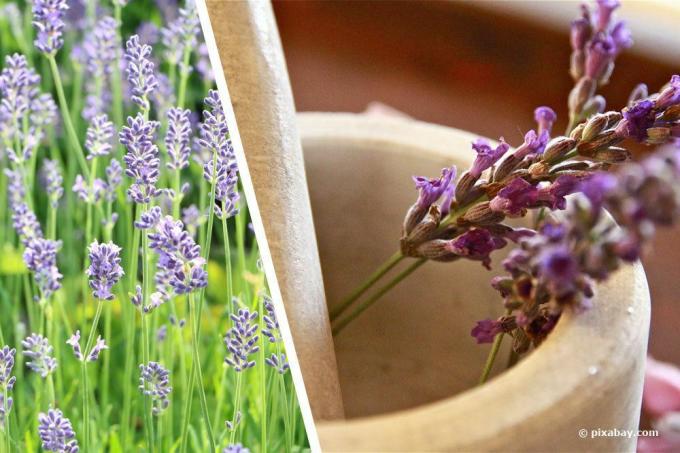
table of contents
- Consumption of lavender
- Which types of lavender are edible?
- Side effects
- What is edible
- Use in the kitchen
- Lavender oil, lavender tea and co
- Shelf life and storage
Lavender is not only popular as a medicinal plant, but also as a culinary herb. But be careful: not all types of lavender are suitable for cooking and eating! We explain what needs to be considered when consuming and processing this crop.
Consumption of lavender
Lavender is one of the non-toxic plants, which is why you might think that it can be consumed without hesitation. However, this is not the case, because not all lavender is edible. Not all types of lavender are suitable for consumption. While some varieties impress with their intense aroma and refine dishes, others provide an almost soap-like taste. That being said, the use of certain strains can lead to unpleasant side effects.
Which types of lavender are edible?
The most common Real lavender used in the kitchen, which can be easily recognized by its narrow leaves. This smells sweet and is reminiscent of rosemary in taste. The situation is different with the crested lavender and the spear lavender: The crested lavender usually tastes too strong because it contains significantly more essential oils. Speiklavender, on the other hand, gives dishes a soap-like note.
In addition to the variety, of course, certain ones also play Quality features an essential role - regardless of whether the lavender is purchased in the garden center or grown in the garden at home:
- pesticide free
- organic farming
- The plant should be healthy and undamaged
- as many side shoots as possible
- fresh smell
tip: The popular crop also grows in the wild, but the Lavandin variety is more common in local regions. However, this is a hybrid form of the spear lavender and the real lavender. However, lavandin is not of such high quality and is usually only partially suitable for cooking.
Side effects
Lavender is generally said to be well tolerated, after all, it has also made a name for itself as a medicinal plant. Among other things, it should provide relief for nervousness and restlessness. It should also be able to alleviate the symptoms of sunburn, rheumatism and colds. However, if consumed in excess, it can irritate the stomach and intestinal mucosa. If Spiked and Cupped lavender are used as essential oils, caution is also advised, because these can have the following effects, among other things:
- convulsive
- Liver damage
- neurotoxic
- abortive

Note: Breastfeeding and pregnant women as well as babies, children and the elderly and sensitive people should only use Spiked and Cupped Lavender under medical supervision.
What is edible
Almost all plant parts of the Lavandula can be used and / or processed in some form. However, they have the mildest and sweetest taste blossoms, which are also ideal as a decoration of salads and any dishes. In addition to the flowers, the shoots and leaves are also edible. However, there are some things to keep in mind when eating lavender leaves:
- Lavender leaves taste more resinous and bitter than flowers
- young leaves are best
- the older the leaves, the more soapy the taste
Use in the kitchen
Lavender is often found in the herb mixture "Herbs of Provence", after all, the useful plant has already become firmly established in Italian and French cuisine. Because the herb is a special one intense aroma it should only be used sparingly to refine dishes. The aromatic plant gives the following dishes a special touch:
- Stews
- Stews
- Ratatouille
- Lamb and game
- Fish dishes
- Goat or sheep cheese dishes
tip: The herb can also add that certain something to desserts by scenting them with lavender sugar or lavender honey. Accordingly, the crop is also suitable for baking cookies and Co.
Lavender oil, lavender tea and co
Lavandula can be consumed both fresh and dried, but it can also be processed further. Among other things, aromatic oils can be made from the plant parts of the lavender, which, depending on the variety, are also suitable for cooking. When buying lavender oil, however, make sure that it is 100% pure oil from real lavender. The processed parts of the plant should also be listed.
The crop can also be processed into salt, vinegar or sugar. Another alternative is a lavender tea, which is said to have a calming and relaxing effect. The hot drink is also quick and easy to prepare:
- Prepare 2 teaspoons of lavender flowers and 250 ml of water
- strain after about 10 minutes
- Sweeten the tea to taste
tip: As an alternative to conventional sugar, there are also stevia or birch sugar!
Shelf life and storage
Freshly harvested lavender can be stored in the refrigerator for a few days. If you want to enjoy the lavandula longer, you can also freeze or dry it. The latter option is particularly popular because the medicinal plant lasts for around six months due to the drying process. If you want to dry the Lavandula, it is best to proceed as follows:
- cut off individual stems
- Tie the stems together to make a bouquet
- hang upside down
- in a dry, dark place
- then store in a sealed, airtight jar

Note: The lavender stalks are not washed before drying because the moisture would encourage mold.





